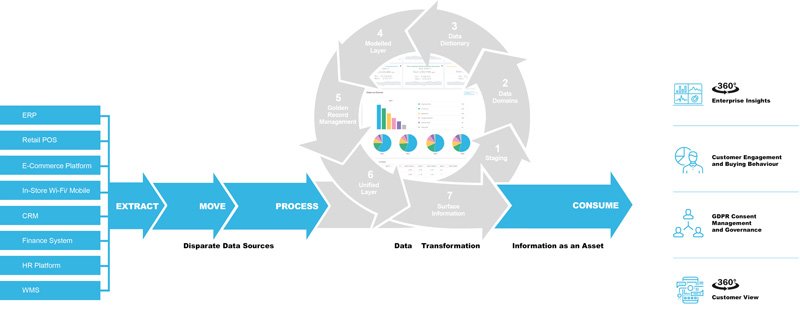The Unified Data Model
30th October 2018
Data is the most important foundation in your company in the 21st century. Without a solid foundation, the rest of the house will fall. The unified data model is the key to those strong foundations.
A few weeks ago, I wrote about the elephant in the room: unified data. If you haven’t read that article yet, to sum up: Bad Data is costing you more than you are probably aware, and unifying your data is the smart long-term investment to enhance your day-to-day view of your customers and improve your offerings.
In this article, I want to discuss the Unified Data Model, the foundation that can stop Bad Data problems and enable your company to start benefitting from good quality data.

Extract your Data
Data and extraction tools gather the data from across your source systems; your CRMs, WMSs and ERPs for example, and makes this information available on a single platform. This stage of the unified data model handles the initial task of unifying your original source systems and the initial bulk collection of data, as well as collecting any new data as it passes into your source systems.
This means every time a new customer is added, updated or deleted from your CRM for example, it will be pulled in the extraction tool to be handled and displayed in a simple way by the end of the process. For this reason, this stage is the foundation for the initial implementation of any data management system and to ensure the continued use of the platform.
Move your Data
The next stage in the Unified Data Model is to take the raw data collected in the extraction stage and move it to the data management platform. This will enable your teams and departments to access the information in a central system, displayed in a way that makes sense.
In its raw form, the data will not make decision-making and customer engagement any easier than it currently is because the extraction tool is just displaying everything from across all source systems in one place. Web services are used to feed this raw data into the platform for processing.
This movement process is constantly looking for new batches from your source systems, which means almost real-time access to your data without manual updates or downtime.
Process your Data
Data domains and dictionaries are set up at this point to tell your data management platform how to read and display the data that is being extracted and moved from your source systems.
The critical stages that provides the true value of a data management platform is the Golden Record management and Unification stages. This is where your data is cleaned to ensure a single true version of your data. Any duplicated or inaccurate records will be removed by the platform at this point.
The Golden Record practice of organising data enables systems to recognise where two records are referring to a single person. For example, John Smith may sign up to a company newsletter using ‘John Smith’ and sign up for a loyalty scheme using ‘Jonathan Smith’. Traditionally, this would create two instances of separate customer records, but with a Golden Record system in place, this customer will show up as a single record, as long as a number of other fields match to authenticate the match.
Consume your Data
This processing makes marketing to John simpler, both from his perspective, and for your Marketing team, who can recognise interactions with John from across all touchpoints. John receives promotions that will interest him and his value as a customer increases with timely, direct and accurate messages that encourage the sale, increase engagement and loyalty.
With a unified data management platform, you can trust and understand your data to evaluate and analyse the performance of specific products, services, and stores at a granularity that isn’t possible any other way.
Final Thoughts
Data is the foundation on which the rest of a company is built. Whether retailers ensure their foundations are strong, or if they try to ignore the problems that are currently growing beneath the surface, will be the difference between success and failure in today’s competitive markets.
If you are currently discovering the challenges of data, I’d love to hear about it. Connect with me on LinkedIn and let me know about your data challenges.
| Written by Kevin Carrick Connect with Kevin on LinkedIn to discuss your data strategy. |
Learn More
